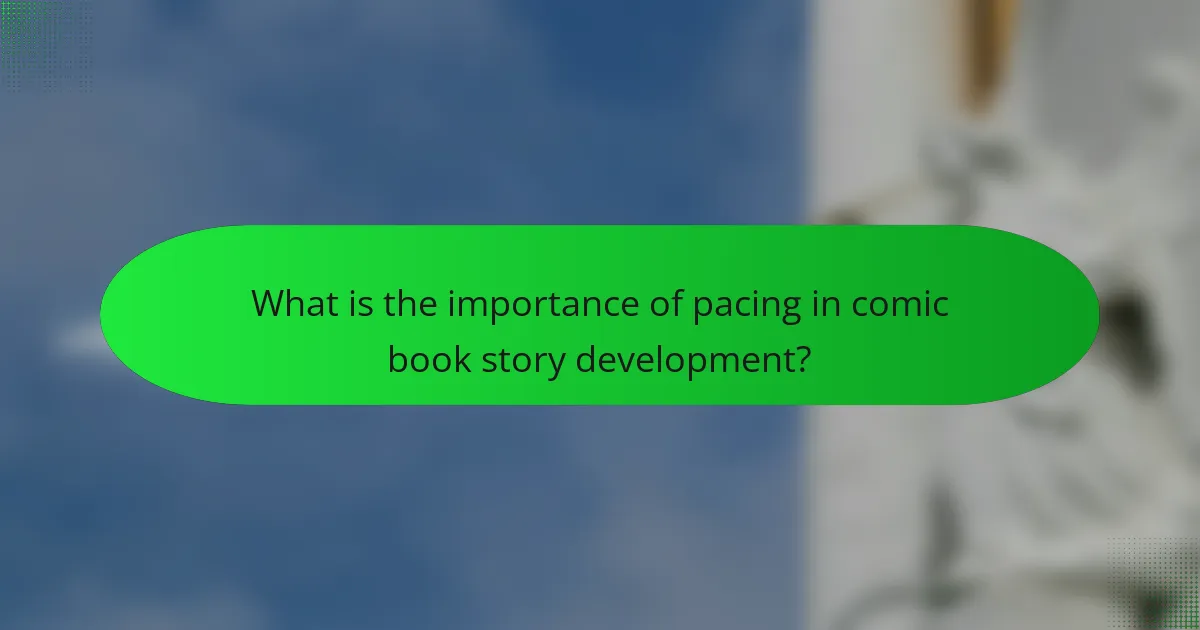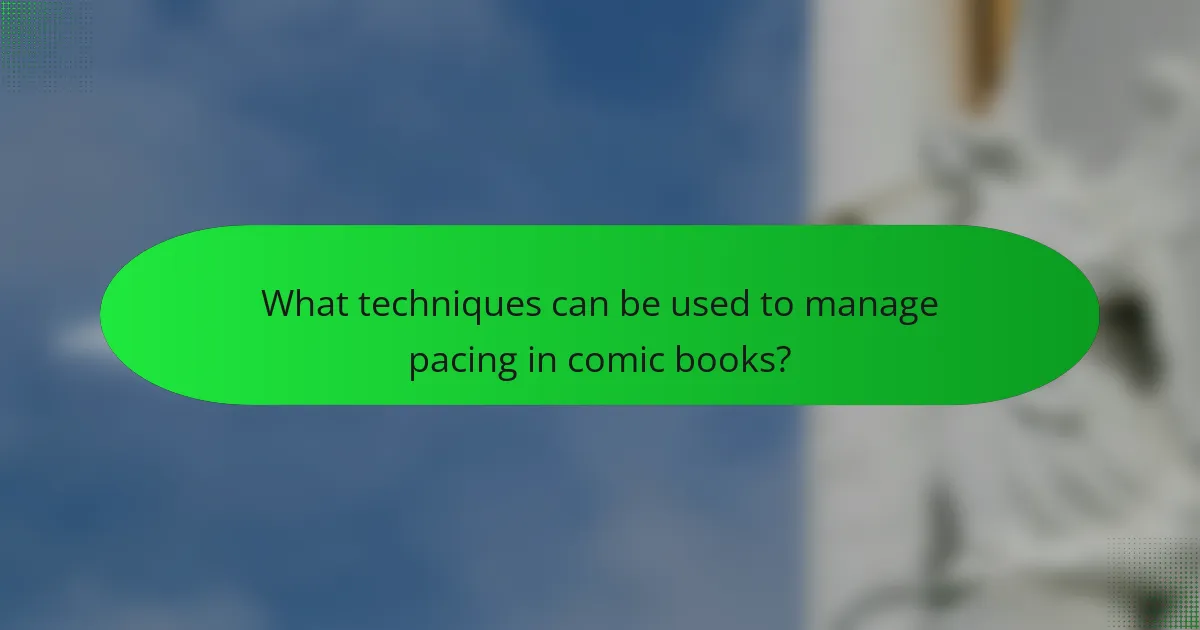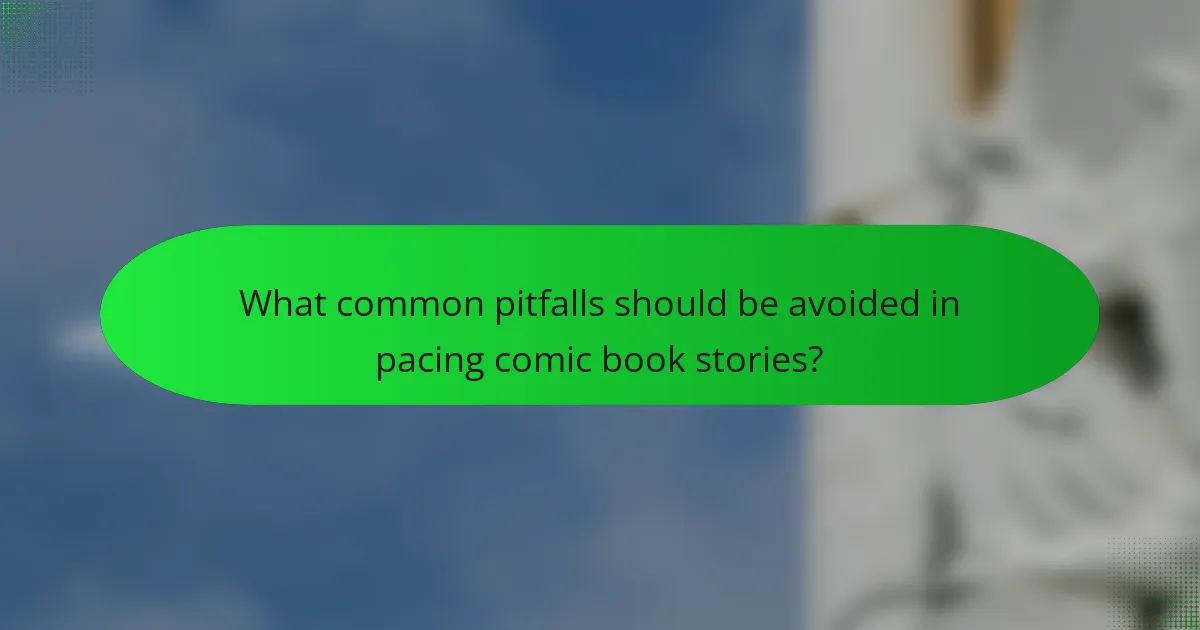Pacing is a critical element in comic book story development that governs narrative flow and reader engagement. Effective pacing balances action, dialogue, and exposition, allowing emotional moments to resonate and building suspense at key junctures. Techniques such as panel size and layout, dialogue rhythm, and strategic silence help manage pacing, influencing how readers experience the story. Common pitfalls include excessive exposition, rushed plot developments, and inconsistent pacing, which can disrupt narrative flow and diminish emotional impact. A well-paced comic enhances reader satisfaction and retention, making it essential for creators to consider each scene’s contribution to the overall narrative.

What is the importance of pacing in comic book story development?
Pacing is crucial in comic book story development as it controls the flow of the narrative. Effective pacing ensures that readers remain engaged throughout the story. It balances action, dialogue, and exposition to maintain interest. Proper pacing allows for emotional beats to resonate with the audience. It also helps to build suspense and tension at key moments. Comic creators often use panel size and layout to influence pacing. For instance, larger panels can slow down the action, while smaller panels can speed it up. Studies show that well-paced stories enhance reader satisfaction and retention.
How does pacing influence the reader’s experience?
Pacing significantly influences the reader’s experience by controlling the flow of the narrative. It affects how quickly or slowly information is revealed in a story. For instance, rapid pacing can create excitement and tension. Conversely, slower pacing allows for deeper character development and reflection. Studies show that pacing impacts emotional engagement. Research indicates that well-paced stories can enhance reader satisfaction. Effective pacing keeps readers invested in the plot. It also helps maintain interest by balancing action and dialogue. Overall, pacing is crucial in shaping the reader’s overall enjoyment and comprehension of the story.
What are the key elements of pacing in storytelling?
The key elements of pacing in storytelling include timing, rhythm, and structure. Timing refers to the speed at which events unfold in the narrative. It influences the reader’s emotional response and engagement. Rhythm involves the flow of scenes and dialogue, creating a balance of action and reflection. Structure encompasses the organization of the story, including the arrangement of plot points and character development. Effective pacing maintains reader interest and enhances suspense. Studies show that well-paced stories can increase reader retention and satisfaction.
How does pacing affect character development?
Pacing significantly influences character development by controlling the timing of character growth and emotional arcs. A slow pacing allows for deeper exploration of a character’s thoughts and motivations. This can lead to more nuanced and relatable characters. Conversely, fast pacing may rush character development, resulting in shallow portrayals. For example, in comic books, a hurried storyline can limit the reader’s connection to character struggles. Studies show that well-paced narratives enhance reader engagement, making characters more memorable. Thus, effective pacing is crucial for creating impactful character journeys.
Why is pacing crucial for narrative structure?
Pacing is crucial for narrative structure because it controls the rhythm and flow of a story. Effective pacing enhances engagement by balancing action and dialogue. It allows readers to absorb information and develop emotional connections. Proper pacing prevents monotony and keeps the audience invested. In comic books, pacing is influenced by panel layout and dialogue placement. Research shows that well-paced stories improve reader comprehension and retention. For instance, a study by M. J. Smith in “The Journal of Graphic Novels” indicates that varied pacing increases reader enjoyment. Thus, pacing is essential for creating compelling narratives.
What role does pacing play in building tension?
Pacing plays a crucial role in building tension by controlling the rhythm of the narrative. Effective pacing creates anticipation and suspense, drawing readers deeper into the story. Slow pacing can heighten emotional stakes, allowing readers to absorb critical moments. Conversely, fast pacing can create urgency and excitement, pushing the plot forward. For example, comic books often use panel layout to manipulate pacing. A series of quick, small panels can generate a rapid sequence of events, increasing tension. In contrast, larger panels with less frequent action can foster a sense of dread or anticipation. Studies show that pacing directly influences reader engagement and emotional response. Thus, the strategic use of pacing is essential for effective tension-building in comic book storytelling.
How can pacing impact plot progression?
Pacing significantly impacts plot progression by controlling the rhythm of storytelling. It determines how quickly or slowly events unfold in a narrative. Effective pacing can build tension and excitement, keeping readers engaged. Conversely, poor pacing may lead to a disjointed or confusing story. For example, rapid pacing can create a sense of urgency during climactic moments. In contrast, slower pacing allows for character development and emotional depth. Studies in narrative structure show that pacing affects reader retention and emotional response. For instance, a well-paced comic can maintain reader interest across multiple issues, enhancing overall story comprehension.

What techniques can be used to manage pacing in comic books?
Techniques to manage pacing in comic books include the use of panel size, layout, and the rhythm of dialogue. Larger panels can emphasize important moments, slowing down the narrative. Conversely, smaller panels can quicken the pace, creating a sense of urgency. Varying the number of panels per page also affects pacing; more panels can lead to a faster read. The placement of dialogue and captions influences how quickly readers consume the story. Strategic use of silence or minimal dialogue can create tension and draw out moments. Additionally, cliffhangers at the end of issues can maintain reader engagement and encourage continued reading. These techniques are widely recognized in comic book storytelling, as seen in works by renowned authors and artists.
How do panel layouts affect pacing?
Panel layouts directly influence pacing in comic books. They determine the flow of time and the rhythm of the narrative. For instance, larger panels can slow down pacing by allowing readers to absorb details. Smaller panels can quicken pacing, creating a sense of urgency. The arrangement of panels also affects how information is processed. A grid layout may provide a steady pace, while an irregular layout can create tension. Studies show that varied panel sizes and arrangements engage readers differently. This engagement impacts how quickly or slowly the story is perceived. Thus, panel layouts are crucial for controlling pacing in comic storytelling.
What are the effects of varying panel sizes on reader engagement?
Varying panel sizes significantly affect reader engagement in comic books. Larger panels tend to draw more attention and can create a sense of importance or drama. They allow for more detailed artwork and can enhance emotional impact. Smaller panels, on the other hand, can increase pacing and create a sense of urgency. They can convey quick actions or rapid sequences effectively. Research indicates that readers often spend more time on larger panels, leading to deeper engagement with the narrative. A study by McCloud in “Understanding Comics” highlights how visual weight influences reader focus. Thus, the strategic use of panel sizes can manipulate reader engagement and enhance storytelling.
How does the use of dialogue influence pacing?
The use of dialogue significantly influences pacing in comic book storytelling. Dialogue can create a rhythm that either accelerates or slows down the narrative flow. Fast-paced dialogue, with short exchanges, can heighten tension and urgency. In contrast, longer, more reflective dialogue can allow for deeper character exploration and emotional depth.
For example, a rapid-fire conversation during a conflict scene can create a sense of chaos. Conversely, a slow, thoughtful exchange can provide readers with necessary context and character development. Studies show that pacing affects reader engagement, with varied dialogue contributing to a dynamic reading experience. This variability keeps readers invested in the story’s progression.
What narrative techniques can enhance pacing?
Narrative techniques that can enhance pacing include dialogue, scene transitions, and varying sentence length. Dialogue can quicken the pace by creating urgency and dynamic exchanges between characters. Scene transitions, such as cuts or flashbacks, can accelerate the narrative flow by shifting the reader’s focus swiftly. Varying sentence length can also influence pacing; short, punchy sentences increase tension, while longer sentences allow for reflection. Additionally, cliffhangers at the end of chapters compel readers to continue. These techniques have been widely recognized in storytelling as essential tools for maintaining reader engagement and momentum.
How do flashbacks and flash-forwards impact pacing?
Flashbacks and flash-forwards can significantly alter the pacing of a narrative. Flashbacks slow down the story’s momentum by providing background information or context. They allow readers to understand characters’ motivations and past events. This can create a deeper emotional connection but may disrupt the flow of the main plot. Conversely, flash-forwards can accelerate pacing by hinting at future events. They create suspense and anticipation, encouraging readers to stay engaged with the unfolding story. By strategically using these techniques, comic book creators can manipulate pacing to enhance storytelling.
What is the significance of cliffhangers in pacing?
Cliffhangers are significant in pacing as they create suspense and anticipation. They serve to engage readers by leaving critical plot points unresolved. This technique encourages readers to continue to the next issue or chapter. Cliffhangers effectively manipulate the flow of the narrative. They can slow down the pacing by prolonging tension. This allows for deeper character development and plot exploration. Studies in narrative theory highlight that unresolved conflicts increase reader investment. Research indicates that cliffhangers can enhance emotional responses, making stories more memorable.

What common pitfalls should be avoided in pacing comic book stories?
Common pitfalls in pacing comic book stories include excessive exposition, rushed plot developments, and inconsistent pacing. Excessive exposition can overwhelm readers, leading to disengagement. Rushed plot developments can leave crucial character arcs unresolved, diminishing emotional impact. Inconsistent pacing can disrupt narrative flow, making it hard for readers to follow the story. Additionally, neglecting to balance action with quieter moments can result in reader fatigue. Effective pacing requires careful consideration of each scene’s contribution to the overall narrative. Maintaining a steady rhythm enhances reader engagement and ensures a satisfying story progression.
What are the signs of poor pacing in comic book narratives?
Signs of poor pacing in comic book narratives include uneven story progression and abrupt shifts in action. When scenes drag on without purpose, reader engagement diminishes. Conversely, if crucial plot points are rushed, the narrative feels disjointed. Excessive exposition can lead to boredom, while too little can confuse readers. Additionally, lack of character development can hinder emotional investment. Inconsistent tone disrupts narrative flow. These issues create a jarring experience, making it difficult for readers to connect with the story.
How can excessive exposition disrupt pacing?
Excessive exposition can disrupt pacing by overwhelming the audience with information. When too much detail is provided at once, it slows down the narrative flow. This can lead to reader disengagement as they struggle to absorb the information. In comic books, visual storytelling relies on a balance of text and imagery. Overloading panels with exposition can clutter the artwork and distract from the story. Studies show that effective pacing maintains reader interest and emotional engagement. For instance, pacing that alternates between action and exposition keeps the reader invested. Therefore, careful management of exposition is crucial for maintaining an engaging rhythm in comic book narratives.
What effects do rushed or dragged-out scenes have on storytelling?
Rushed scenes can lead to confusion and disengagement from the audience. They often compress critical plot developments, sacrificing character depth. This can result in a lack of emotional impact. Conversely, dragged-out scenes can create tension but may also lead to boredom. Extended sequences can enhance character development and world-building. However, excessive length can detract from narrative momentum. Effective pacing balances these elements, maintaining audience interest and emotional resonance. Studies in narrative theory support that pacing significantly influences reader engagement and satisfaction.
What best practices can improve pacing in comic book development?
To improve pacing in comic book development, creators should utilize a balance of dialogue, visuals, and action. Effective pacing requires careful consideration of panel layouts. Varying panel sizes can create a rhythm that enhances storytelling. Additionally, strategic use of white space can allow readers to absorb key moments. Integrating cliffhangers at the end of chapters keeps readers engaged. Releasing content in digestible segments maintains interest over time. Feedback from beta readers can identify pacing issues early in the process. Finally, analyzing successful comic series can provide valuable insights into effective pacing techniques.
How can writers effectively plan pacing throughout a series?
Writers can effectively plan pacing throughout a series by establishing a clear structure for each installment. This structure should include a balance of action, dialogue, and exposition. Writers should map out key plot points and character arcs in advance. Consistency in pacing helps maintain reader engagement across issues. Utilizing cliffhangers at the end of chapters can create anticipation for the next installment. Additionally, varying the pacing in different sections can enhance emotional impact. For example, slower pacing can build tension, while faster pacing can convey urgency. An analysis of successful comic series shows that effective pacing contributes to overall storytelling success.
What tools or resources can assist in managing pacing?
Storyboarding software can assist in managing pacing in comic book story development. Tools like Storyboard That and Toon Boom Storyboard Pro allow creators to visualize their narratives. These platforms provide templates and drag-and-drop features for easy arrangement of scenes. They help in determining the timing and flow of each panel. Additionally, pacing can be managed using scripts and outlines. Resources like Celtx and Final Draft facilitate structured writing. These tools help writers organize dialogue and action sequences effectively. They ensure that pacing aligns with the overall narrative structure.
The main entity of the article is pacing in comic book story development. Pacing is essential as it controls the narrative flow, balancing action, dialogue, and exposition to maintain reader engagement and enhance emotional resonance. Key elements of pacing include timing, rhythm, and structure, which influence character development and plot progression. Techniques such as panel size and layout, dialogue management, and cliffhangers are discussed as methods to effectively manage pacing. The article also addresses common pitfalls in pacing, signs of poor pacing, and best practices for improving pacing throughout a comic book series.